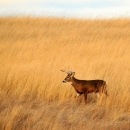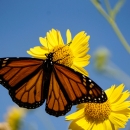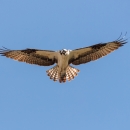Seasons of Wildlife
Spring
April:
Ospreys and red-cockaded woodpeckers are nesting. Eaglets begin to fly. Warbler and shorebird migration peaks early in the month. Mississippi and swallow-tailed kites can be seen along the roads and pools.
May:
Purple gallinules can sometimes be seen in the East River Pool and Plum Orchard Pond behind the Visitor Center. Wood storks are occasionally viewed in Headquarters Pond. Ospreys are feeding and shading their young. Larger groups of West Indian Manatees can be seen in the waters of the lighthouse.
June:
Turkey broods are present in refuge woods. Deer are often seen with their fawns. Ospreys, red-cockaded woodpeckers, purple gallinules and moorhens all have young fledglings.
Summer
July:
Large flocks of white ibis, eastern kingbirds, and purple martins are seen along Lighthouse Road. Wood storks are often seen in the shallow waters of headquarters pond.
August:
Baby alligators are hatching from their nests. Deer are busy caring for newborn fawns. The arrival of blue-winged teal signals the start of the fall migration.
September:
Bald eagles return to nest, and many butterflies, including the sulfur, swallowtail, and skipper feed along the roadsides. This month also sees a blaze of brilliant autumn wildflowers.
Fall
October:
This month sees the arrival of the migratory Monarch butterfly. Viceroy, Queen, American Painted Beauty and Gulf Fritillary butterflies are also common. Northern harriers return to hunt over the refuge marshes.
November:
November generally brings in the cold weather, so butterflies and wildflowers become scarce. Waterfowl populations reach their peak between Thanksgiving and Christmas.
December:
Clear cool days are great for spotting wildlife such as bobcats, deer, bear, and river otter. Kestrels, red-tailed hawks and red-shouldered hawks are commonly seen along Lighthouse Road. Bald Eagles begin to nest.
Winter
January:
Waterfowl are commonly seen in the Refuge pools and in Apalachee Bay. Eagles are nesting. Otters and bobcats can be seen in the early morning and late afternoon.
February:
Great Blue herons begin nesting. Great horned owls are feeding their owlets. Ospreys return to the Refuge. Wood ducks begin nesting and bluebirds work on their nest cavities.
March:
Spring migration begins. Ibis and white pelicans migrate through the Refuge as the ducks head north. Alligators can be seen basking in the sun on warmer days.







